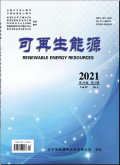可再生能源2024,Vol.42Issue(5):601-611,11.
基于太阳能和双有机朗肯循环的液态空气储能系统特性研究
Performance analysis on liquid air energy storage system based on solar energy and dual Organic Rankine Cycle
摘要
Abstract
In order to solve the problem of incomplete utilization of waste heat in traditional solar thermal storage liquid air energy storage systems(LAES-S)and further improve the round-trip efficiency of the system,a liquid air energy storage system(LAES-S-O)coupled with solar thermal storage and a dual Organic Rankine Cycle on the basis of the LAES-S system is developed.The thermodynamic model of the coupled system is established,and the influence of key parameters on system performance is analyzed.The results show that the net output power of subsystems ORC1 and ORC2 is 1 296 kW and 6 695.83 kW under typical operating conditions;the round-trip efficiency of the new system can reach 117.63%;the exergy efficiency is 38.97%;and the energy efficiency is 28.88%,which are 12.58%,2.35%,and 1.21%higher than those of the reference system,respectively.In addition,the system provides domestic hot water at a temperature of 364.15 K to the users,achieving cogeneration efficacy.Sensitivity analysis of key parameters shows that when the liquefaction pressure(compressor outlet pressure)increases from 15 MPa to 18 MPa and the liquefaction temperature(throttle inlet air temperature)rises from 93.15 K to 113.15 K,the air liquefaction rate,round-trip efficiency,and exergy efficiency decrease with the increase of liquefaction pressure,and the increase of liquefaction pressure and temperature is not conducive to the system performance;however,when the exhaust pressure increases from 5.3 MPa to 7.7 MPa,the round-trip efficiency and the exergy efficiency increases.The research results can provide some theoretical support for the liquid-air-coupled solar system.关键词
太阳能/液态空气储能/有机朗肯循环/余热利用/敏感性分析Key words
solar energy/liquid air energy storage/Organic Rankine Cycle/waste heat utilization/sensitivity analysis分类
能源与动力引用本文复制引用
史科锐,莫春兰,党玉荣,方颖聪,张子杨,李作顺..基于太阳能和双有机朗肯循环的液态空气储能系统特性研究[J].可再生能源,2024,42(5):601-611,11.基金项目
广西创新驱动发展专项(桂科AA19254010). (桂科AA19254010)

